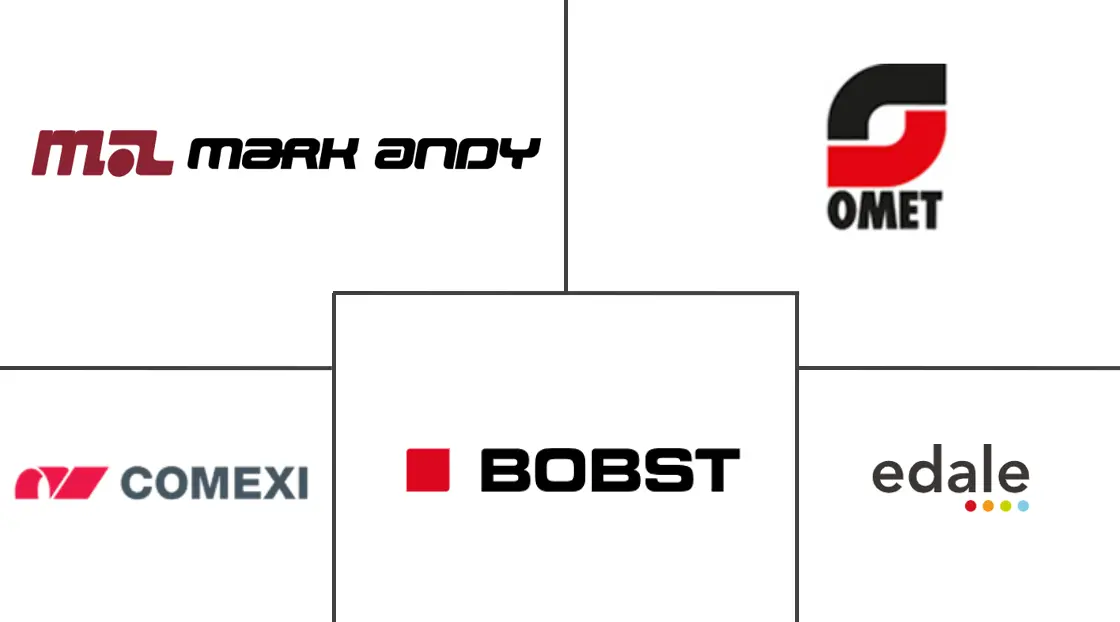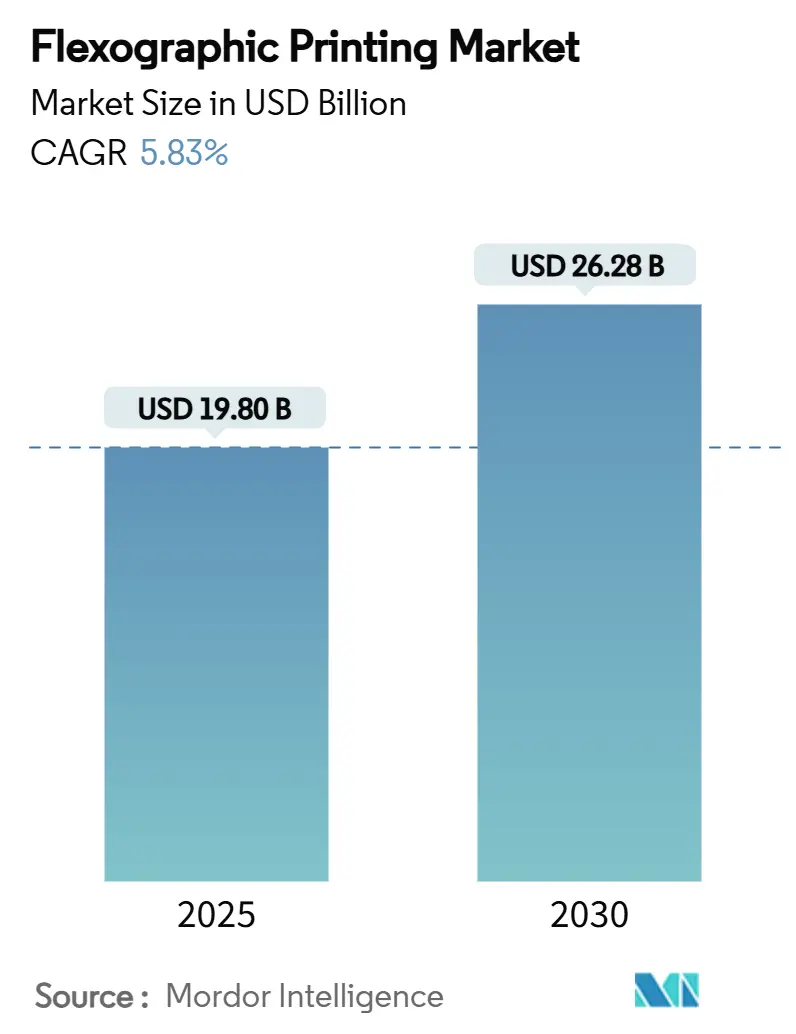
Flexographic Printing Market Analysis by Mordor Intelligence
The flexographic printing market size stood at USD 19.80 billion in 2025 and is forecast to reach USD 26.28 billion by 2030, translating to a robust 5.83% CAGR over the period. Rising e-commerce volumes, stringent food-contact regulations, and continuous improvements in AI-enabled press automation are expected to uphold this momentum in the flexographic printing market. Equipment vendors are optimizing narrow-web and digital-hybrid presses to serve brands that juggle shorter SKU life cycles, while converters intensify water-based ink adoption to comply with global VOC thresholds. Growing demand for sustainable corrugated logistics, together with investments in rapid plate-mounting and inspection systems, keeps the flexographic printing market well placed against competing lithography and gravure methods. Asia-Pacific’s manufacturing capacity, paired with government incentives for circular packaging, further cements the region’s leadership role in the flexographic printing market.
Key Report Takeaways
- By printing equipment, narrow-web presses led with 30.84% revenue share in 2024, while digital-hybrid systems are projected to advance at 9.24% CAGR.
- By ink type, water-based formulations accounted for 40.87% of the flexographic printing market size in 2024; UV-curable inks are set to expand at 8.42% CAGR.
- By substrate type, paper and paperboard led with 45.78% revenue share in 2024, while flexible plastic films are projected to advance at 7.98% CAGR.
- By application, flexible packaging is projected to climb at 8.21% CAGR to 2030, overtaking labels, which retained 28.87% revenue share in 2024.
- By end-user industry, healthcare and pharmaceuticals are anticipated to record the fastest 9.21% CAGR, even as food and beverage held 34.59% share of the flexographic printing market size in 2024.
- By geography, Asia-Pacific commanded 38.32% of flexographic printing market share in 2024, and the region is forecast to grow at 9.23% CAGR through 2030.
Global Flexographic Printing Market Trends and Insights
Drivers Impact Analysis
| Driver | (~) % Impact on CAGR Forecast | Geographic Relevance | Impact Timeline |
|---|---|---|---|
| Brand-owner demand for shorter SKU cycles | +1.2% | Global; North America and EU most active | Medium term (2-4 years) |
| Cost-effective long-run package printing | +0.9% | Asia-Pacific core; spill-over into MEA | Long term (≥ 4 years) |
| Water-based ink adoption for food compliance | +1.1% | Global; led by North America and EU regulations | Short term (≤ 2 years) |
| Sustainable corrugated logistics | +0.8% | Global; earliest traction in Europe and North America | Medium term (2-4 years) |
| AI-driven press automation | +1.0% | Asia-Pacific and North America, expanding across the EU | Long term (≥ 4 years) |
| E-commerce multi-wall mailers | +0.7% | Global; concentrated in urban fulfillment hubs | Short term (≤ 2 years) |
| Source: Mordor Intelligence | |||
Brand-owner Demand for Shorter SKU Cycles
Consumer preferences now turn over faster than ever, pushing brand managers to refresh packaging artwork frequently. Converters respond by leaning on narrow-web presses that complete plate changes in minutes, curbing downtime and material waste. Solutions such as the Onyx GO deliver active register control that lowers setup scrap by 30%. [1]Uteco Converting S.p.a., “Onyx GO,” uteco.comShorter runs also let retailers pilot seasonal editions without carrying surplus inventory, reducing the working-capital burden throughout the flexographic printing market. In parallel, cloud-based workflow software accelerates artwork approvals, ensuring that new designs progress from concept to shelf within weeks.
Cost-Effective Long-Run Package Printing
Where volumes exceed millions of impressions, flexography still offers the lowest unit cost. Photopolymer plates last hundreds of thousands of cycles, while energy-efficient dryers reduce operating expenses. DuPont’s Orion case illustrates 30% solvent savings after migrating from gravure to flexo, along with safer shop-floor conditions. [2]DuPont, “Orion adopts advanced flexography,” dupont.comSuch economics keep legacy consumer-goods lines anchored in the flexographic printing market, preserving press utilization and spare-parts sales for OEMs. Asian converters, often running three shifts, maximize these cost advantages to meet export-driven demand.
Water-Based Ink Adoption for Food Contact Compliance
Regulators on both sides of the Atlantic cap solvent residues in primary packaging, steering printers toward water-based or low-migration UV sets. These formulations eliminate hazardous VOCs and demonstrate strong adhesion on paper as well as treated films. TROY Group’s UV/LED low-migration inks meet FDA 21 CFR §175.300 limits while cutting curing energy by up to 60%. [3]TROY Group, “Inks for Food Packaging,” troygroup.com Early adopters enjoy premium supplier status with multinational food producers, and that differentiation supports price realization in the flexographic printing market.
Shift Toward Sustainable Corrugated Logistics
E-retail generates parcel volumes that favor shock-resistant, easily recycled corrugated boxes. Flexo presses equipped with anilox rolls optimized for high-porosity liners deliver bold graphics without crushing micro-flutes. The EU Circular Economy Action Plan accelerates this shift by stipulating recycled-content thresholds. Logistics firms also cite reduced pallet weight, shrinking emissions throughout the supply chain. Converters able to certify paper provenance under FSC or PEFC gain access to retailer “green-label” programs, lifting overall demand in the flexographic printing market.
Restraints Impact Analysis
| Restraint | (~) % Impact on CAGR Forecast | Geographic Relevance | Impact Timeline |
|---|---|---|---|
| Digital inkjet cannibalisation in short runs | -0.8% | Global; most acute in highly automated economies | Short term (≤ 2 years) |
| Volatile photopolymer plate prices | -0.6% | Global; supply chain concentrated in Asia | Medium term (2-4 years) |
| Solvent-based VOC regulations tightening | -0.7% | North America and EU, gradually affecting APAC | Medium term (2-4 years) |
| Skilled press-operator shortage | -0.5% | Global; widest gap in North America and EU | Long term (≥ 4 years) |
| Source: Mordor Intelligence | |||
Digital Inkjet Cannibalisation in Short Runs
Advances in piezo-electric heads and aqueous dispersion inks enable variable data and near-offset image quality at competitive click rates. Pharmaceutical packagers integrate digital lines with ERP software to produce country-specific leaflets on demand, cutting inventory to zero. In response, the flexographic printing market is pivoting to hybrid presses that merge in-line inkjet stations with conventional units, preserving established finishing workflows while adding serialization capability.
Volatile Photopolymer Plate Prices
Elastomer and resin feedstocks remain exposed to petrochemical swings and geopolitical uncertainty. Spot surcharges reached double-digit percentages in late 2024, eroding gross margins for converters locked into annual supply contracts. Liquid plate technology, pioneered by MacDermid, promises lower raw-material intensity and localized production, though adoption still sits below 5% of all new plate volumes. Stable plate pricing is critical for job costing accuracy, and volatility continues to temper expansion plans in the flexographic printing market.
Segment Analysis
By Printing Equipment Type: Digital-Hybrid Drives Innovation
Digital-hybrid presses lifted their share of new installations as converters sought one line that could alternate between mass-production mode and personalized batches. Although narrow-web machines secured 30.84% of revenue in 2024, the hybrid cohort is on course for 9.24% CAGR, well above the overall flexographic printing market. Typical configurations combine 10-color flexo decks for brand colors with CMYK inkjet bars placed just before the rewinder. Such set-ups reduce job changeover time to under five minutes, keeping lines profitable even when average order quantities fall below 5,000 linear m. Medium-web lines remain favored in tissue overwraps and snack wrappers, while wide-web CI flexo retains dominance in stand-up pouches. Sheet-fed presses serve folding cartons that require precise die-cutting stations downstream.
Converters equipping themselves with modular platforms can later bolt on corona treaters, chill rolls, or second inkjet bars as client mixes evolve. The SapphireLUCE exemplifies this modular path, pairing 1200 × 1200 DPI resolution with speeds of 150 mpm. Service-level agreements often bundle predictive-maintenance analytics, shrinking unplanned downtime below 2% of available hours. These feature sets sustain pricing power for OEMs, even as the broader flexographic printing market experiences competitive pressure from refurbished presses in emerging economies.
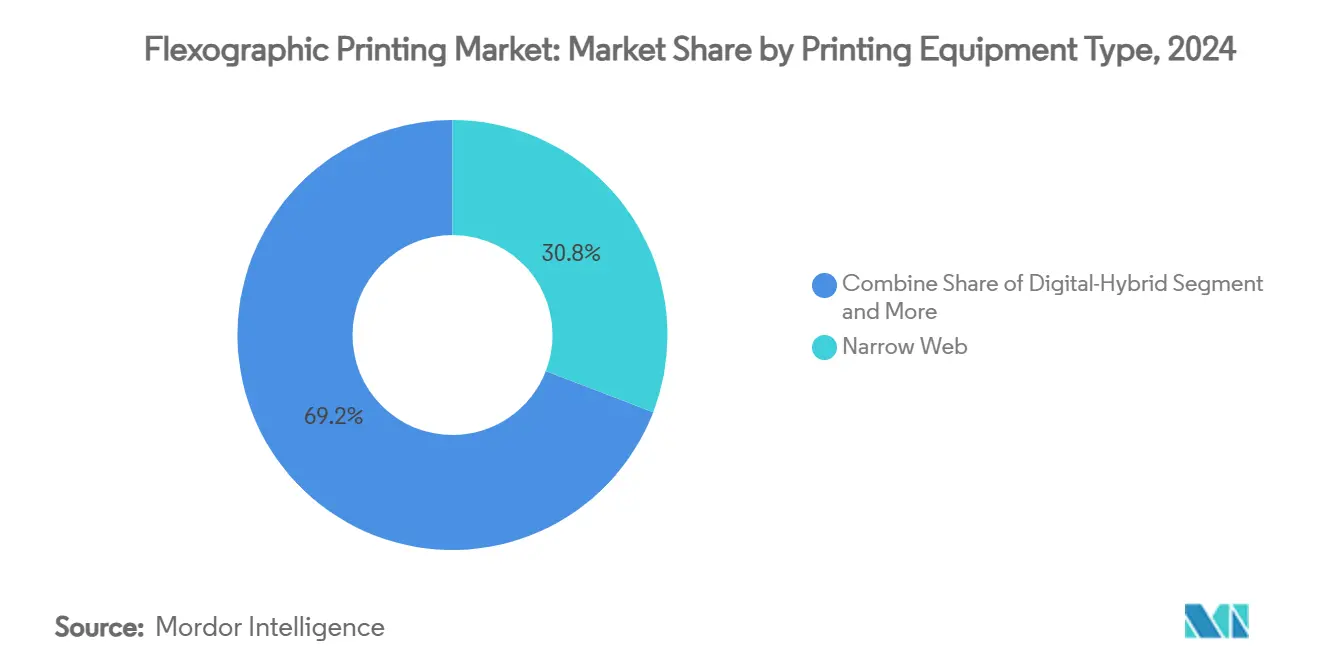
Note: Segment shares of all individual segments available upon report purchase
By Ink Type: UV-Curable Gains Despite Water-Based Dominance
Water-based systems commanded 40.87% revenue in 2024 thanks to low odour and direct-food-contact approval in most jurisdictions. They form the baseline chemistry for corrugated boxes, folding cartons, and paper wraps. UV-curable inks, however, are projected to register 8.42% CAGR through 2030 because they support higher line speeds and excellent scratch resistance on non-porous films. Energy-curable solutions require compact LED lamps that draw 65% less power than mercury arc units, reducing plant electricity bills. Solvent variants, constrained by tightening VOC caps under the US EPA Part 59 ruling, continue to cede share. Electron-beam curables remain a niche at under 2% penetration but show promise in dairy lidding and aseptic cartons.
Ink suppliers differentiate through pigment dispersion stability, rheology control, and low-migration additive packages. INX International’s GelFlex EB ink removes lamination in certain snack applications, dropping gauge weight and cutting foil usage. Such innovations echo the broader sustainability narrative resonating throughout the flexographic printing market.
By Substrate Type: Flexible Films Challenge Paper Dominance
Paper and paperboard still represented 45.78% of print surface area in 2024, propelled by surge demand for e-commerce shippers. By contrast, multi-layer PE, PP, and PET films are forecast to advance at 7.98% CAGR, outpacing earlier projections due to expanded grocery delivery. Metallised foils safeguard aroma and light-sensitive foods, maintaining relevance despite recyclability debates. High-barrier films treated with plasma enable mono-material pouches, opening a new sustainability pathway that keeps plastics competitive.
Brand owners now pilot chemically recycled feedstock, allowing drop-in grades that meet soon-to-mature recycled-content mandates. National Flexible’s protein-bar wrapper using 70% recycled PET underscores this commercial reality. Such case studies highlight how substrate evolution directly shapes capex plans in the flexographic printing market.
By Application: Flexible Packaging Outpaces Traditional Segments
Label lines generated 28.87% of revenue in 2024, but flexible packaging is on track for 8.21% CAGR as omni-channel retail demands robust mailer protection. Corrugated shippers retain core logistics applications yet transition toward premium inside-print graphics for improved unboxing experiences. Folding cartons, challenged by substrate substitutions, maintain share where structural rigidity is essential. Print media continues its secular contraction as brand owners redirect budgets to digital channels.
Converters serving fresh produce tap variable-data flexo to print traceability QR codes each shift. Emerald Packaging deploys this model across 2 billion pouches annually, reflecting a broader pivot toward on-pack engagement. These use cases expand value capture within the flexographic printing market beyond traditional food branding.
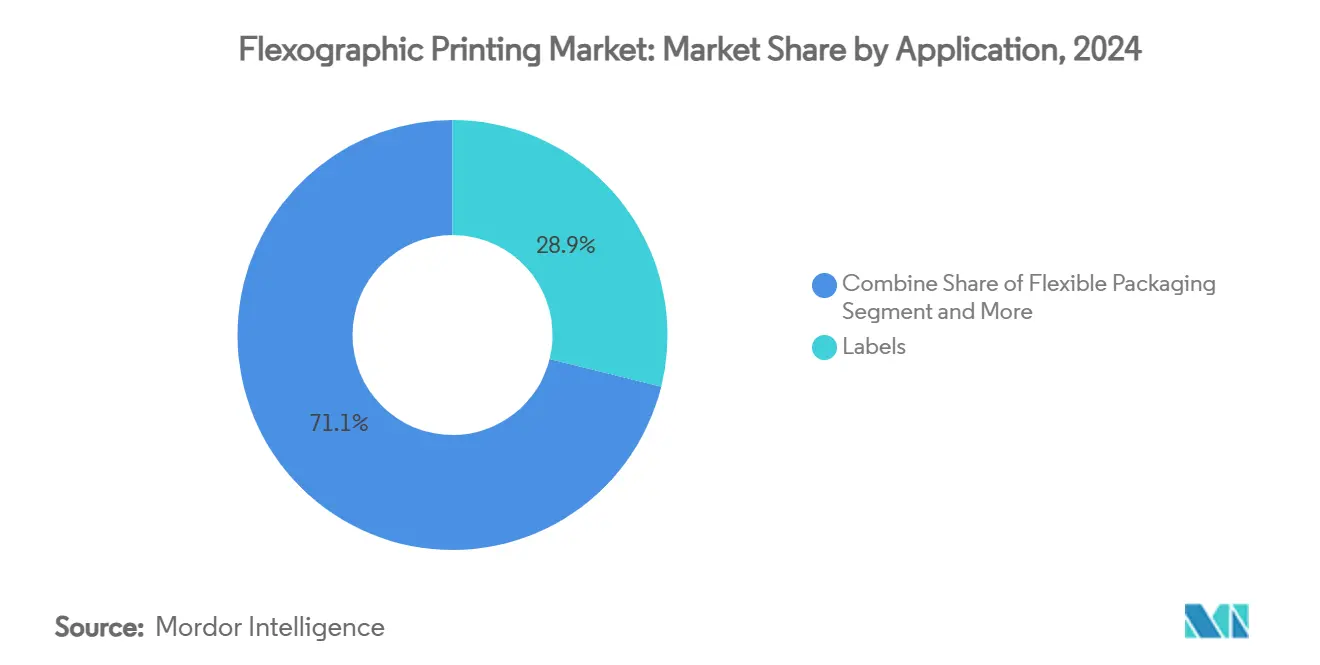
Note: Segment shares of all individual segments available upon report purchase
By End-User Industry: Healthcare Drives Premium Growth
Food and beverage producers consumed 34.59% of total press output in 2024, riding consistent staple-goods demand. Healthcare and pharmaceuticals, however, will log the highest 9.21% CAGR as serialization rules spread worldwide. OTC drugs and medical-device labels require micro-text, high-contrast barcodes, and tamper-evident varnishes, functions well supported by high-line-screen anilox rolls. Personal care brands prioritize metallic effects and natural-fiber substrates, delivering steady premium volumes. Industrial firms, such as chemical drum suppliers, value UV-resistant inks that survive outdoor storage.
WestRock integrates blister-card and leaflet production under ISO 13485 protocols, offering turnkey solutions that simplify vendor qualification for drug companies. Such specialist capability underpins margin resilience in the flexographic printing market’s healthcare vertical.
Geography Analysis
Asia-Pacific generated the largest revenue slice at 38.32% in 2024 and is projected to compound at 9.23% CAGR to 2030. China supplies substrates, inks, and machinery, enabling integrated cost synergies, while India posts double-digit e-commerce parcel growth that fuels domestic packaging demand. Japan and South Korea emphasize automation, pioneering press lines equipped with cobot-assisted roll changes. Government recycling targets across ASEAN incentivize water-based inks and mono-material pouch designs, broadening addressable opportunities throughout the flexographic printing market.
North America remains the technology pioneer, hosting pilot runs for AI-driven inspection cameras and cloud-connected viscosity controllers. Brand owners reward converters that demonstrate FDA-compliant low-migration workflows, sustaining high value-added print per square meter. Labor shortages persist, prompting initiatives like Ricoh’s Advanced Career Education program that trains operators in press-side data analytics. Nearshoring trends reroute consumer-goods manufacturing from Asia to Mexico, spurring fresh investments in CI flexo lines within North America.
Europe maintains keen regulatory oversight, compelling swift adoption of plant-based photoinitiators and mineral-oil-free ink sets under the Zero Pollution framework. Germany anchors engineering excellence, France accelerates bio-plastic packaging, and Italy scales narrow-web competence hubs such as Bobst’s 1,200 sqm Florence center. Eastern European converters leverage favorable wage structures to absorb overflow orders, reinforcing the region’s diverse role in the flexographic printing market.
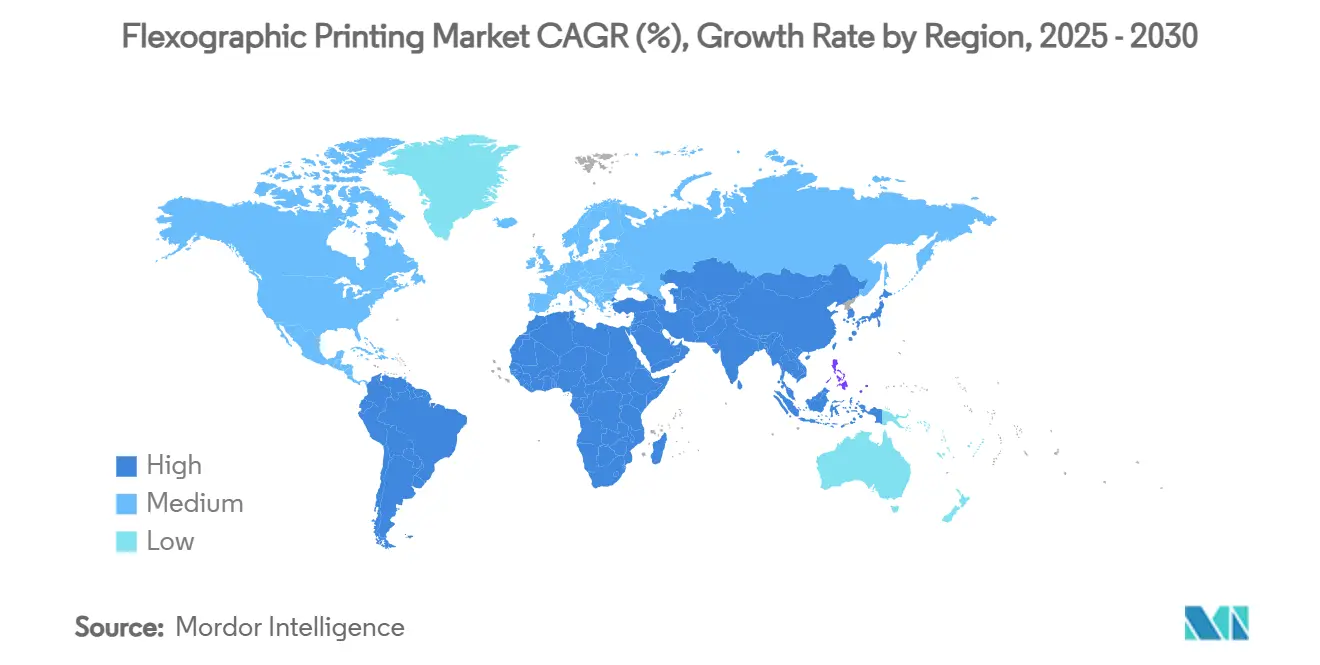
Competitive Landscape
The global flexographic printing market is moderately concentrated, with the top five press and pre-press suppliers combining to cover between 35% and 45% of annual equipment billings. Bobst, Heidelberger Druckmaschinen, Mark Andy, Koenig & Bauer, and SOMA sustain differentiation through integrated workflow software, remote diagnostics, and flexible service contracts. Each has introduced AI modules that dynamically adjust ink keys and tension settings, reducing waste by up to 20%. XSYS’s acquisition of MacDermid Graphics Solutions expanded vertical integration into photopolymer plates, fortifying supply stability for large converter groups.
New entrants focus on single-pass inkjet architectures or regionalized service models that promise faster spare-parts delivery. However, buyers still value proven color-management libraries and long-life mechanical frames. SOMA’s Optima press uses machine-learning vision to flag print variations in milliseconds, highlighting how incumbents fuse software with hardware to defend share. Across the flexographic printing market, price competition intensifies in mid-tier CI presses, yet premium hybrid lines preserve double-digit margins.
Strategic alliances also shape competition. Bobst collaborates with apex roller specialists to optimize cell geometry, while ink vendors partner with OEMs to certify low-migration recipes ahead of legislation. Consolidation is set to continue as suppliers seek scale to fund R&D and meet end-user sustainability scorecards. The resulting ecosystem favors participants that can deliver cradle-to-cradle solutions, spanning plate imaging, anilox cleaning, and digital twin simulations.
Flexographic Printing Industry Leaders
-
Bobst Group SA
-
OMET S.r.l
-
Comexi Group
-
Mark Andy Inc.
-
Edale Ltd.
- *Disclaimer: Major Players sorted in no particular order
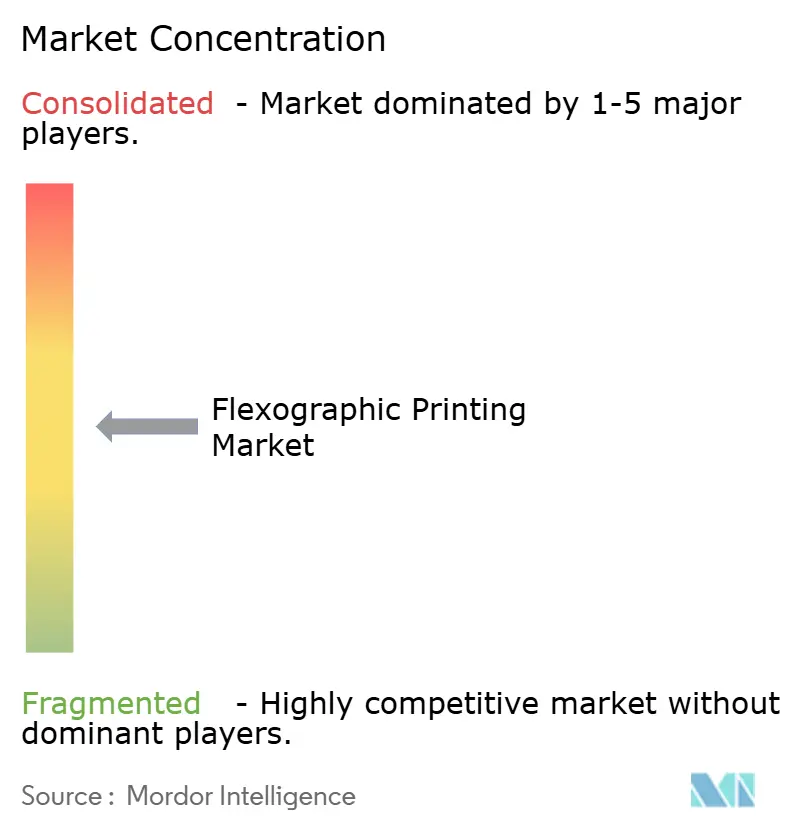
Recent Industry Developments
- January 2025: Bobst opened a 1,200 sqm Competence Center in Florence, Italy, featuring inline flexo, digital, and All-in-One lines.
- January 2025: UFlex confirmed participation in PrintPack India 2025 to showcase UV and water-based ink systems.
- December 2024: Uteco partnered with ACIMGA and UNI to define sustainability standards for flexographic presses
- September 2024: Mark Andy highlighted next-gen flexo at Labelexpo with strong customer uptake.
Global Flexographic Printing Market Report Scope
Flexographic printing is a printing process that utilizes flexible plates formed of rubber or plastic. Each plate, with its lightly extended image, is wheeled on a cylinder and applied with fast-drying ink. The substance to be printed on, or the substrate, is passed between the print plates and the roller, which uses pressure to keep the substrate against the plate. The study evaluates the revenue generated from selling various types of flexographic printing inks and equipment provided by vendors operating in the market.
The flexographic printing market is segmented by application (corrugated boxes, folding cartons, flexible packaging, labels, print media, and other applications) and geography (North America [United States and Canada], Europe [United Kingdom, Germany, France, Italy, Spain, and Rest of Europe], Asia-Pacific [China, India, Japan, Australia and New Zealand, and Rest of Asia-Pacific], Latin America, and Middle East and Africa). The market sizes and forecasts are provided in terms of value (USD) for all the above segments.
| Narrow Web |
| Medium Web |
| Wide Web |
| Sheet-Fed |
| Digital-Hybrid |
| Water-Based |
| Solvent-Based |
| UV-Curable |
| Electron-Beam |
| Paper and Paperboard |
| Flexible Plastic Films |
| Metallic Foil |
| Other Substrate Type |
| Corrugated Boxes |
| Folding Carton |
| Flexible Packaging |
| Labels |
| Print Media |
| Other Application |
| Food and Beverage |
| Healthcare and Pharmaceuticals |
| Personal Care and Cosmetics |
| Industrial |
| Other End-user Industry |
| North America | United States | |
| Canada | ||
| Mexico | ||
| Europe | Germany | |
| United Kingdom | ||
| France | ||
| Italy | ||
| Spain | ||
| Russia | ||
| Rest of Europe | ||
| Asia-Pacific | China | |
| India | ||
| Japan | ||
| South Korea | ||
| Australia and New Zealand | ||
| Rest of Asia-Pacific | ||
| Middle East and Africa | Middle East | United Arab Emirates |
| Saudi Arabia | ||
| Turkey | ||
| Rest of Middle East | ||
| Africa | South Africa | |
| Nigeria | ||
| Egypt | ||
| Rest of Africa | ||
| South America | Brazil | |
| Argentina | ||
| Rest of South America | ||
| By Printing Equipment Type | Narrow Web | ||
| Medium Web | |||
| Wide Web | |||
| Sheet-Fed | |||
| Digital-Hybrid | |||
| By Ink Type | Water-Based | ||
| Solvent-Based | |||
| UV-Curable | |||
| Electron-Beam | |||
| By Substrate Type | Paper and Paperboard | ||
| Flexible Plastic Films | |||
| Metallic Foil | |||
| Other Substrate Type | |||
| By Application | Corrugated Boxes | ||
| Folding Carton | |||
| Flexible Packaging | |||
| Labels | |||
| Print Media | |||
| Other Application | |||
| By End-user Industry | Food and Beverage | ||
| Healthcare and Pharmaceuticals | |||
| Personal Care and Cosmetics | |||
| Industrial | |||
| Other End-user Industry | |||
| By Geography | North America | United States | |
| Canada | |||
| Mexico | |||
| Europe | Germany | ||
| United Kingdom | |||
| France | |||
| Italy | |||
| Spain | |||
| Russia | |||
| Rest of Europe | |||
| Asia-Pacific | China | ||
| India | |||
| Japan | |||
| South Korea | |||
| Australia and New Zealand | |||
| Rest of Asia-Pacific | |||
| Middle East and Africa | Middle East | United Arab Emirates | |
| Saudi Arabia | |||
| Turkey | |||
| Rest of Middle East | |||
| Africa | South Africa | ||
| Nigeria | |||
| Egypt | |||
| Rest of Africa | |||
| South America | Brazil | ||
| Argentina | |||
| Rest of South America | |||
Key Questions Answered in the Report
What is the current value of the flexographic printing market?
The flexographic printing market size reached USD 19.80 billion in 2025.
How fast is the flexographic printing market expected to grow?
The market is forecast to post a 5.83% CAGR between 2025 and 2030.
Which region leads the flexographic printing market?
Asia-Pacific holds 38.32% revenue share and will pace growth at 9.23% CAGR through 2030.
What equipment segment is expanding the quickest?
Digital-hybrid presses are projected to rise at 9.24% CAGR owing to their ability to handle both long and short runs efficiently.
Why are water-based inks so prominent in flexographic printing?
They meet tightening food-contact and VOC regulations while supporting sustainable packaging goals, securing 40.87% market share in 2024.
Which end-user vertical is projected to grow the fastest?
Healthcare and pharmaceuticals will expand at 9.21% CAGR as serialization mandates spread worldwide.
Page last updated on:
